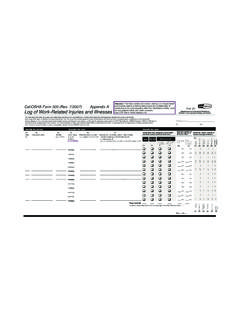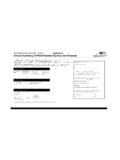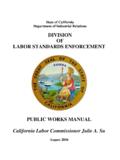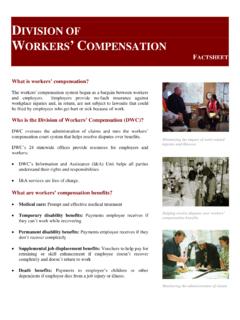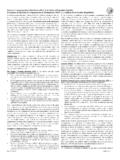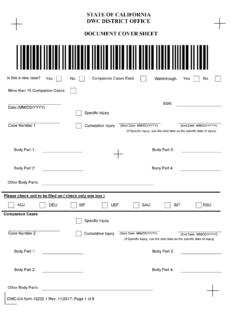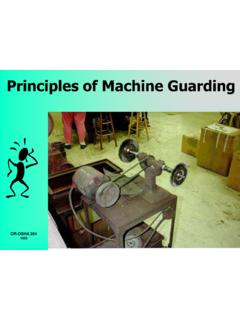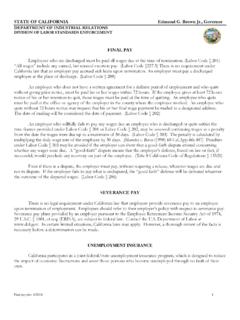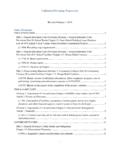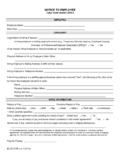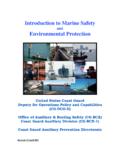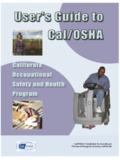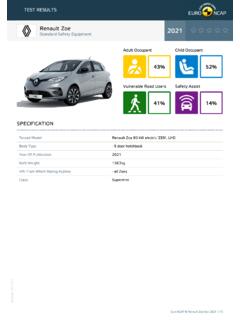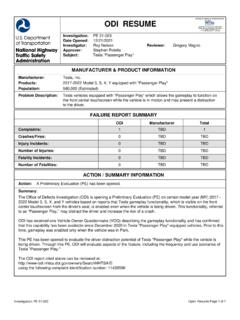Transcription of Comparison of Cal/OSHA and Federal OSHA programs
1 FACT SHEET. Comparison of Cal/OSHA and Federal OSHA programs GREATER LEVELS OF PROTECTION UNDER Cal/OSHA . Permissible Exposure Limits (air contaminants) Federal OSHA is still using their original 1970 permissible exposure limits (PEL). Cal/OSHA reviews PELs continuously to determine if they should be updated. Since the original Federal OSHA PELs from the 1970s, Cal/OSHA has added to or revised its PELs more than 20 times. Examples include: Acetone (a widely used solvent). California s PEL @ 500 ppm, Federal PEL @ 1000ppm Aniline (used to produce the chemical MDI, and used in rubber processing, herbicides, and dyes and pigments).
2 California s PEL @ ppm, Federal PEL @ ppm Manganese (used in steelmaking, and production of stainless steel and aluminum). California s PEL @ mg/m3, Federal PEL @ mg/m3. Cal/OSHA standards (non-PEL) more protective than Federal OSHA. Control of Employee Exposure to Concrete and Masonry Dust (including silica). Washing Facilities at Construction Jobsites Notification to the Division of Lead-Related Work Hand Weeding, Hand Thinning, and Hand Hot Capping Operations in Agriculture Ventilation Requirements for Laboratory-Type Hood Operations Confined Spaces Bloodborne Pathogen amendments Hazard Communication amendments Aerosol Transmissible Disease/Zoonotics High Rise Window Cleaning Cal/OSHA has a very active program one of only two programs in the country.
3 Cal/OSHA s serves as a model for the country and has prompted changes in American National Standards Institute standards that govern window cleaning equipment. Ergonomic Standard California s has had an ergonomic standard since the late 1990s Process safety Management Cal/OSHA has two offices focused solely on PSM with dedicated staff. The Feds inspect under a National Emphasis Program which only provides a snapshot of operations at the time of the inspection. Cal/OSHA makes regular visits to facilities, to conduct Program Quality Verification reviews, respond to complaints, conduct fatality investigations, evaluate chemical releases and fires, and investigate explosions.
4 The unit is very active in outreach, participating in quarterly safety summits and seminars, and working closely with other agencies. Mining and Tunneling Unit Cal/OSHA has regulatory authority over mining, milling and finishing operations whereas the Federal Mine safety and Health Administration only covers mining and milling. Critical standards applicable to these operations are better defined and more stringent in California with regard to guardrails, ladder way openings, fall protection and crane operator certifications. In tunnel safety , Cal/OSHA has higher standards than Fed/OSHA in that we require all tunnel construction jobs to have a State-certified safety representative and gas tester on site.
5 We also require a pre-construction meeting and the Labor Code mandates compliance inspections every 2 months when a tunnel is under construction. Cal/OSHA COVERAGE WHERE THERE IS NO Federal COUNTERPART. Diacetyl Cal/OSHA adopted a standard in 2010 that regulates employee exposure to this food flavoring used extensively to flavor microwave popcorn and other food products. Acute exposure to diacetyl can lead to pulmonary problems, including bronchiolitis obliterans, a permanent and irreversible lung condition. Federal OSHA has no comparable standard. High-rise Window Cleaning Cal/OSHA has one of only two programs in the United States and is considered a national model.
6 Our work in this area has resulted in changes to the American National Standards Institute standards used throughout the United States. Our standard requires an annual inspection of equipment on buildings which support window cleaning by a third-party inspector approved by the Division. Federal OSHA. has no comparable program. Injury and Illness Prevention Program (IIPP) Implemented in the early 1990 s, the California program has served as a model that Federal OSHA is now evaluating for possible adoption at the national level. This program requires every employer to have a safety and health program tailored to their specific workplace.
7 California employers have found that the benefits of these programs include improved workplace safety and health, better morale, increased productivity and reduced costs of doing business. Ergonomics California adopted a Repetitive Motion Injury (RMI) standard in the late 1990 s. The standard applies to a job, process, or operation where a RMI has occurred to more than one employee under certain conditions. Every employer subject to this section must have a program that includes worksite evaluation, control of exposures and training of employees. Federal OSHA has no comparable standard. Economic and Employment Enforcement Coalition (EEEC) In 2005, California launched an effort to suppress the underground economy by conducting enforcement sweeps in targeted industries employing low- wage workers such as agriculture, car washes, pallet operations, and the garment industry.
8 Citing and penalizing unscrupulous employers is perceived as a way to reduce the profile of these operations thereby benefiting law abiding employers. Cal/OSHA has eleven staff members assigned to the EEEC. There is no permanent Department of Labor counterpart. Heat Illness Prevention Program In 2006, Cal/OSHA promulgated an emergency standard to protect outdoor workers from the hazards of working in high heat environments. Since that time, thousands of inspections have been conducted as well as thousands of outreach, training and education sessions all intended to raise the awareness of the employer community and employees to how they can protect themselves.
9 An encouraging trend has been noted since 2006 in that the rate of in-compliance inspections has been increasing. From a high of twelve heat related fatalities to one last year, it has become apparent that an experiment such as this underscores the value of a concentrated effort with equal areas of emphasis in enforcement and voluntary compliance. Federal OSHA has no comparable program. Aerosol Transmissible Disease In 2009, California adopted the nation s first standard to safeguard workers from the spread of airborne diseases. The standard is designed to protect workers in healthcare and related industries from the spread of diseases such as tuberculosis, measles, influenza and other pathogens by coughing and sneezing.
10 It focuses on healthcare and related workplaces that typically treat, diagnose, or house individuals who may be ill such as hospitals, clinics, nursing care facilities, correctional facilities, and homeless shelters. It also covers emergency responders. The ATD standard requires healthcare employers and others at increased risk to develop exposure control procedures and train employees to follow them. Federal OSHA. has no comparable standard. 2. INNOVATIONS. Special Advisory Committees Cal/OSHA has a long history of reaching out to a range of stakeholders through the Cal/OSHA Advisory Committee. Additionally, special advisory committees are convened to address specific emerging issues such as re-evaluating PELs (Health Expert Advisory Committee), Aerosol Transmissible Disease, Heat Illness Prevention, and others.
